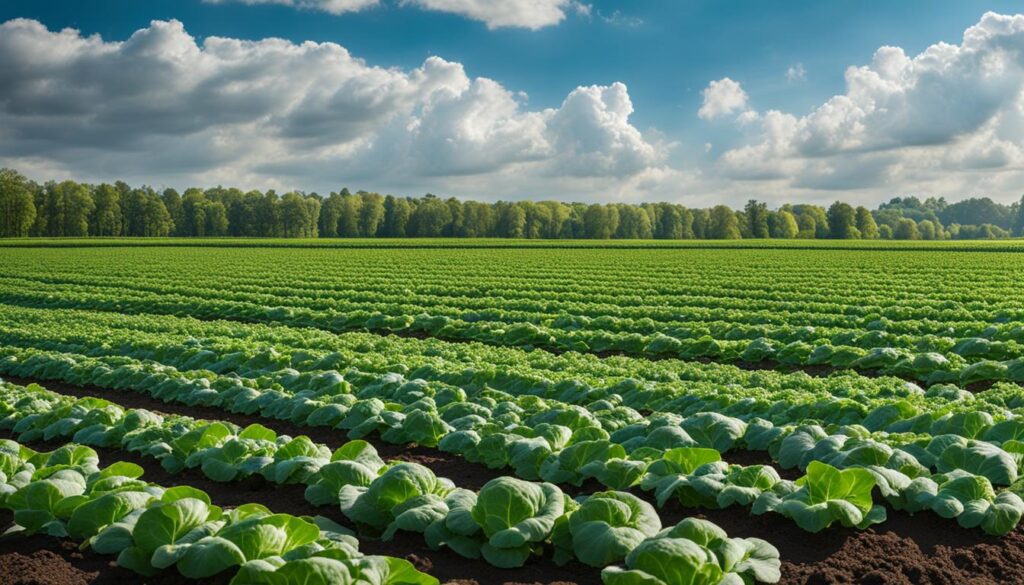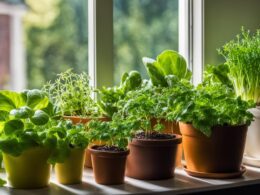If you’re looking to maximize your garden space and grow a variety of nutritious vegetables, consider planting Brussels sprouts and cauliflower together. These cool weather crops not only have similar climate requirements but can also benefit from companion planting strategies. In this guide, we’ll provide you with essential tips and techniques for successful cultivation of Brussels sprouts and cauliflower in your garden.
Post Summary:
- Brussels sprouts and cauliflower are cool weather vegetables that thrive in temperatures between 65 and 80 F.
- Planting them as transplants in fertile, well-drained soil with a pH level between 6.0 and 7.0 is recommended.
- Proper spacing, watering, and fertilizer application are crucial for successful growth.
- Companion planting with aromatic plants can help deter pests and attract beneficial insects.
- Avoid planting other brassicas or heavy-feeding plants near Brussels sprouts and cauliflower to prevent competition.
Climatic and Soil Requirements for Growing Brussels Sprouts And Cauliflower Together
When it comes to growing Brussels sprouts and cauliflower together, understanding their climatic and soil requirements is crucial for a successful harvest. Both vegetables thrive in cool weather, making spring and fall the ideal seasons for cultivation. Brussels sprouts and cauliflower prefer daytime temperatures between 65 and 80 F, although cauliflower is more sensitive to heat. To ensure proper growth, it is recommended to plant transplants rather than seeds.
In terms of soil requirements, Brussels sprouts and cauliflower thrive in well-drained soils with added organic matter. It is important to set out the transplants in moist soil that has been enriched with organic matter. Adding a layer of mulch can help maintain cool and moist conditions, which are beneficial for the growth of these vegetables. Additionally, the pH level of the soil should ideally be between 6.0 and 7.0 to discourage clubroot disease and optimize nutrient availability.
Proper fertilization is also essential for the healthy development of Brussels sprouts and cauliflower. Conducting a soil test is recommended to determine the specific fertilizer and lime requirements. As a general guideline, applying 2 to 3 pounds of 8-16-16 fertilizer per 100 square feet of garden area can provide the necessary nutrients for these vegetables to thrive.
| Vegetable | Climatic Requirements | Soil Requirements |
|---|---|---|
| Brussels Sprouts | Cool weather with daytime temperatures between 65 and 80 F | Well-drained soil with a pH level between 6.0 and 7.0 |
| Cauliflower | Cool weather with daytime temperatures between 65 and 80 F | Well-drained soil with a pH level between 6.0 and 7.0 |
Climate Requirements
When it comes to climate requirements, both Brussels sprouts and cauliflower prefer cool weather. They can tolerate a wide range of temperatures but thrive best when daytime temperatures are between 65 and 80 F. It’s important to note that cauliflower is more sensitive to heat than Brussels sprouts. Therefore, it is crucial to plant them during the appropriate seasons, such as spring or fall, to avoid exposing them to excessive heat.
Soil Requirements
For successful growth, Brussels sprouts and cauliflower require well-drained soil. It’s essential to choose a location with good drainage to prevent waterlogging, which can lead to root rot. Additionally, these vegetables prefer soil with a pH level between 6.0 and 7.0. Maintaining the optimal pH level ensures nutrient availability and discourages diseases like clubroot.
By understanding the climatic and soil requirements for growing Brussels sprouts and cauliflower together, you can create the ideal conditions for a bountiful harvest. Remember to provide the right temperatures, well-drained soil, and maintain the optimal pH level to ensure the health and development of these cool weather vegetables.
Cultivars and Planting Tips for Growing Brussels Sprouts And Cauliflower Together
When it comes to growing Brussels sprouts and cauliflower together, choosing the right cultivars is crucial for a successful harvest. For Brussels sprouts, some recommended cultivars include ‘Green Comet,’ ‘Packman,’ ‘Green Hornet,’ and ‘Premium Crop.’ These varieties have proven to be reliable and produce excellent quality sprouts. On the other hand, cauliflower enthusiasts can opt for cultivars such as ‘Snow Crown,’ ‘Snow King,’ ‘Snowball 123,’ and ‘Imperial 10-6,’ which are known for their impressive heads.
To ensure optimal growth, it’s essential to follow proper planting tips for both crops. Brussels sprouts can be planted as early as April 1st, while cauliflower is best planted in mid-summer for a fall harvest. When it comes to spacing, Brussels sprouts should be planted 18 inches apart in the row, with 24 inches between rows. Cauliflower requires a bit more space, with plants set 24 inches apart in the row and 30 inches between rows.
Watering is another crucial aspect of successful cultivation. Consistent watering helps establish the transplants and promotes head development. Keep the soil consistently moist, but be careful not to overwater, as it can lead to rot and other diseases. Additionally, it’s important to provide adequate nutrients to support healthy growth. Once the plants are well-established, extra nitrogen fertilizer may be necessary to ensure they receive the necessary nutrients.
Summary:
- Choose recommended cultivars like ‘Green Comet’ and ‘Snow Crown’ for Brussels sprouts and cauliflower, respectively.
- Plant Brussels sprouts early in the season and cauliflower in mid-summer for a fall harvest.
- Space Brussels sprouts 18 inches apart in the row and 24 inches between rows. For cauliflower, set plants 24 inches apart in the row and 30 inches between rows.
- Consistent and adequate watering is essential for establishment and head development.
- Provide additional nitrogen fertilizer once the plants are well-established.
| Crop | Recommended Cultivars |
|---|---|
| Brussels Sprouts | ‘Green Comet’, ‘Packman’, ‘Green Hornet’, ‘Premium Crop’ |
| Cauliflower | ‘Snow Crown’, ‘Snow King’, ‘Snowball 123’, ‘Imperial 10-6’ |
Companion Planting for Brussels Sprouts And Cauliflower
Companion planting is a beneficial technique for growing Brussels sprouts and cauliflower together in your garden. By strategically placing certain plants near your crops, you can help deter pests and attract beneficial insects, creating a healthier and more balanced ecosystem in your garden. Here are some companion plants that work well with Brussels sprouts and cauliflower:
- Onions, garlic, shallots, and chives: These aromatic plants help repel pests like aphids and cabbage worms.
- Beets: Beets act as a trap crop, attracting pests away from your Brussels sprouts and cauliflower.
- Mint, dill, sage, and rosemary: These herbs can deter insects and add a pleasant aroma to your garden.
- Marigolds: French marigolds are known to repel root nematodes and also discourage insect pests from attacking the sprout stalks.
- Nasturtiums: These colorful flowers not only add beauty to your garden but also act as a trap crop for aphids and repel brassica pests.
By including these companion plants in your garden, you can create a diverse and harmonious environment that supports the growth and health of your Brussels sprouts and cauliflower. These companion plants not only help deter pests but also attract beneficial insects like ladybugs, lacewings, and hoverflies that prey on destructive pests. This natural pest management approach can reduce the need for chemical pesticides and promote organic and sustainable gardening practices.
Companion planting for Brussels sprouts and cauliflower is not only a practical pest management solution but also offers several other benefits. The interplanting of different crops creates a visually appealing and dynamic garden, while the varied scents and aromas can confuse pests and mask the presence of the target crops. Additionally, companion plants can provide shade, act as windbreakers, and improve soil structure and fertility through their root systems. Overall, companion planting enhances the health and productivity of your garden ecosystem.
It’s important to note that when selecting companion plants, you should avoid planting other brassicas, strawberries, or heavy-feeding plants like tomatoes and peppers near your Brussels sprouts and cauliflower. These plants can compete for resources and potentially damage your crops. Plan your garden layout carefully to ensure compatibility and maximize the benefits of companion planting for Brussels sprouts and cauliflower.
| Companion Plants | Pest Control | Beneficial Insects Attracted |
|---|---|---|
| Onions, garlic, shallots, chives | Repel aphids and cabbage worms | Attract ladybugs and lacewings |
| Beets | Act as trap crop for pests | N/A |
| Mint, dill, sage, rosemary | Deter insects | N/A |
| Marigolds | Repel root nematodes and insect pests | N/A |
| Nasturtiums | Repel brassica pests, act as trap crop for aphids | Attract hoverflies and other beneficial insects |
Companion planting is a holistic approach to gardening that promotes natural pest control, maximizes space utilization, and enhances the overall health and productivity of your garden. By incorporating companion plants alongside your Brussels sprouts and cauliflower, you can create a thriving garden ecosystem that benefits both your crops and the environment.
Conclusion
Congratulations on completing this guide to growing Brussels sprouts and cauliflower together! By following the tips and techniques outlined in this article, you are well on your way to successful cultivation of these delicious vegetables.
Remember to provide the ideal climatic and soil conditions for your crops, ensuring they thrive in the cool weather they prefer. Choose recommended cultivars that are suitable for your home garden and pay attention to proper spacing and watering. Implement companion planting strategies to deter pests and attract beneficial insects, creating a harmonious garden ecosystem.
With consistent care and attention, you can look forward to a bountiful harvest of Brussels sprouts and cauliflower. Enjoy the satisfaction of growing your own nutritious and flavorful vegetables, and savor the rewards of your hard work in the kitchen.
FAQ
What are the optimal climatic requirements for growing Brussels sprouts and cauliflower together?
Brussels sprouts and cauliflower thrive in cool weather, with optimal daytime temperatures ranging from 65 to 80 F. They can be grown in the spring and fall.
How should I prepare the soil for growing Brussels sprouts and cauliflower?
The soil should be fertile, well-drained, and have a pH level between 6.0 and 7.0. Adding organic matter and mulching can help maintain moisture levels.
What are some recommended cultivars for growing Brussels sprouts and cauliflower in a home garden?
Recommended cultivars for Brussels sprouts include ‘Green Comet,’ ‘Packman,’ ‘Green Hornet,’ and ‘Premium Crop.’ For cauliflower, ‘Snow Crown,’ ‘Snow King,’ ‘Snowball 123,’ and ‘Imperial 10-6’ are good choices.
How should I space and water Brussels sprouts and cauliflower plants?
Brussels sprouts should be planted 18 inches apart in the row, with 24 inches between rows. Cauliflower requires more space, with plants set 24 inches apart in the row and 30 inches between rows. Watering should be consistent to establish the transplants and promote head development.
Can companion planting help with pest management for Brussels sprouts and cauliflower?
Yes, companion planting can be beneficial. Some recommended companion plants include onions, garlic, shallots, chives, beets, mint, dill, sage, rosemary, marigolds, and nasturtiums. These plants can help deter pests and attract beneficial insects.











